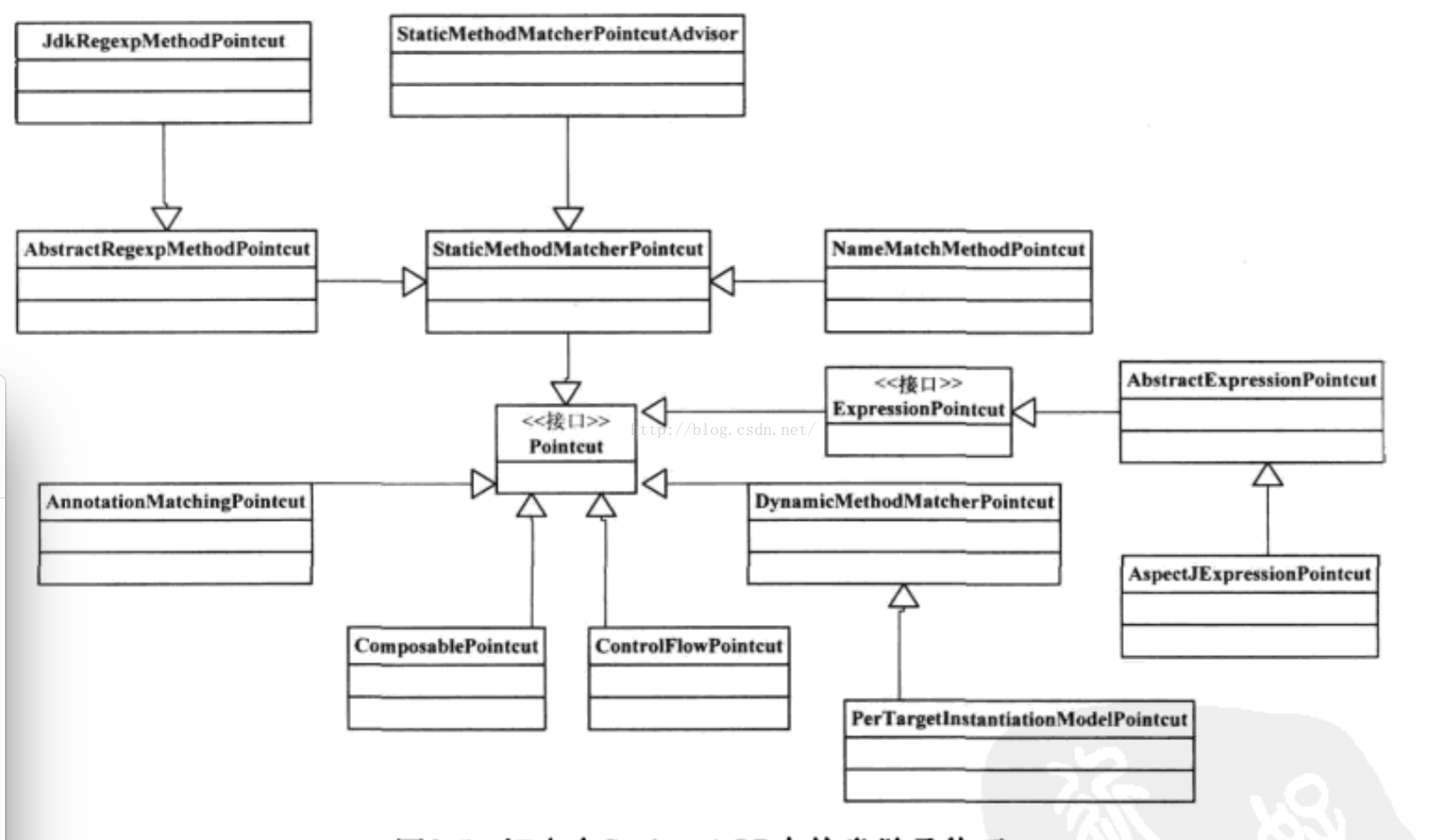AOP 概述
1, AOP:Aspect-Oriented Programming:一种模块化机制,用来描述分散在对象,类或方法中的横切关注点。从关注点中分离出横切关注点是面向切面编程的核心概念。分离关注点使解决特定领域的代码从业务逻辑中独立出来,业务逻辑代码不再有对特定领域代码的调用。特定领域的问题通过切面封装,维护,这样子分散在整个应用程序的变动就可以很好的管理。
2, Adivice通知
Advice定义连接点做什么,为切面增强提供织入接口。在Spring AOP中,主要描述Spring AOP围绕方法调用而注入的切面行为。
Spring提供了更具体的通知类型,比如BeforeAdvice,AfterAdvice等。
下面以BeforeAdvice为例:
BeforeAdvice是一个标记接口(marker interface).
public interface BeforeAdvice extends Advice {
}
具体我们看MethodBeforeAdvice接口。
public interface MethodBeforeAdvice extends BeforeAdvice {
void before(Method method, Object[] args, Object target) throws Throwable;
}
具体参数:method:目标方法的反射对象。args:方法执行参数。target:方法执行的对象。以CountingBeforeAdvice为例,该类完成统计被调用方法的次数。
public class CountingBeforeAdvie implements MethodBeforeAdvice{
public void before(Method method, Object[] args, Object target) throws Throwable{
count(method);
}
}
count方法通过hashMap存储Method对象和调用次数。
2,Pointcut切点
Pointcut切点决定Advice通知作用于哪个连接点,就是说通过Pointcut来定义需要增强的方法集合。
Spring以Pointcut接口为中心,实现了一系列的类。
3,Advisor通知器
Advisor通知器定义在哪个切点Pointcut使用哪个Advice。
以Advisor的实现DefaultPointcutAdvisor为例。在DefaultPointcutAdvisor中,有两个成员变量,分别是pointCut和Advice。
public class DefaultPointcutAdvisor extends AbstractGenericPointcutAdvisor implements Serializable
private Pointcut pointcut = Pointcut.TRUE;public DefaultPointcutAdvisor(Pointcut pointcut, Advice advice) {this.pointcut = pointcut;setAdvice(advice);}
public interface Pointcut {/*** Return the ClassFilter for this pointcut.* @return the ClassFilter (never {@code null})*/ClassFilter getClassFilter();/*** Return the MethodMatcher for this pointcut.* @return the MethodMatcher (never {@code null})*/MethodMatcher getMethodMatcher();/*** Canonical Pointcut instance that always matches.*/Pointcut TRUE = TruePointcut.INSTANCE;}
我们看到Pointcut引用的TRUE成员。这里使用的是单例(singleton,书中称为单件,感觉比较奇怪)。
查看TruePointcut
class TruePointcut implements Pointcut, Serializable {public static final TruePointcut INSTANCE = new TruePointcut();/*** Enforce Singleton pattern.*/private TruePointcut() {}@Overridepublic ClassFilter getClassFilter() {return ClassFilter.TRUE;}@Overridepublic MethodMatcher getMethodMatcher() {return MethodMatcher.TRUE;}/*** Required to support serialization. Replaces with canonical* instance on deserialization, protecting Singleton pattern.* Alternative to overriding {@code equals()}.*/private Object readResolve() {return INSTANCE;}@Overridepublic String toString() {return "Pointcut.TRUE";}}
Spring AOP的设计与实现
1,JVM的动态代理特性
JVM的动态代理有关可以参考:http://blog.csdn.net/mergades/article/details/42173893
2,Spring AOP的设计
Spring AOP的设计核心即使动态代理模式。
3,配置ProxyFactoryBean
ProxyFactoryBean是在Spring IoC环境中创建AOP应用的底层方法,Spring通过该类完成了对AOP使用的封装。ProxyFactoryBean的配置和使用如下:
-1,定义使用的通知器Advisor,这个通知器通过Bean定义,并实现了对应的切面行为。
-2,定义ProxyFactoryBean,把它作为另一个Bean来定义,它使封装AOP功能的主要类。
-3,定义target属性。
4,ProxyFactoryBean生成AOPProxy对象。
在Spring中可以同各国ProxyFactoryBean来完成对AOP的配置目标对象和切面行为。我们可以查看其对应的属性:
public class ProxyFactoryBean extends ProxyCreatorSupportimplements FactoryBean<Object>, BeanClassLoaderAware, BeanFactoryAware {/*** This suffix in a value in an interceptor list indicates to expand globals.*/public static final String GLOBAL_SUFFIX = "*";protected final Log logger = LogFactory.getLog(getClass());private String[] interceptorNames;//已经定好的通知器private String targetName;//目标对象private boolean autodetectInterfaces = true;private boolean singleton = true;private AdvisorAdapterRegistry advisorAdapterRegistry = GlobalAdvisorAdapterRegistry.getInstance();private boolean freezeProxy = false;private transient ClassLoader proxyClassLoader = ClassUtils.getDefaultClassLoader();private transient boolean classLoaderConfigured = false;private transient BeanFactory beanFactory;/** Whether the advisor chain has already been initialized */private boolean advisorChainInitialized = false;/** If this is a singleton, the cached singleton proxy instance */private Object singletonInstance;
ProxyFactoryBean依赖JDK的动态代理或者CGLIB提供的PROXY属性。
在该类中,getObject()方法对通知链进行初始化。并对Singleton和prototype类型的对象做出区分。
public Object getObject() throws BeansException {initializeAdvisorChain();if (isSingleton()) {return getSingletonInstance();}else {if (this.targetName == null) {logger.warn("Using non-singleton proxies with singleton targets is often undesirable. " +"Enable prototype proxies by setting the 'targetName' property.");}return newPrototypeInstance();}}
initializeAdvisorChain()方法:
private synchronized void initializeAdvisorChain() throws AopConfigException, BeansException {if (this.advisorChainInitialized) {return;//如果已经初始化,则直接返回。}if (!ObjectUtils.isEmpty(this.interceptorNames)) {if (this.beanFactory == null) {throw new IllegalStateException("No BeanFactory available anymore (probably due to serialization) " +"- cannot resolve interceptor names " + Arrays.asList(this.interceptorNames));}// Globals can't be last unless we specified a targetSource using the property...if (this.interceptorNames[this.interceptorNames.length - 1].endsWith(GLOBAL_SUFFIX) &&this.targetName == null && this.targetSource == EMPTY_TARGET_SOURCE) {throw new AopConfigException("Target required after globals");}
// Materialize interceptor chain from bean names.
//根据配置,添加调用for (String name : this.interceptorNames) {if (logger.isTraceEnabled()) {logger.trace("Configuring advisor or advice '" + name + "'");}if (name.endsWith(GLOBAL_SUFFIX)) {if (!(this.beanFactory instanceof ListableBeanFactory)) {throw new AopConfigException("Can only use global advisors or interceptors with a ListableBeanFactory");}addGlobalAdvisor((ListableBeanFactory) this.beanFactory,name.substring(0, name.length() - GLOBAL_SUFFIX.length()));}else {// If we get here, we need to add a named interceptor.// We must check if it's a singleton or prototype.Object advice;if (this.singleton || this.beanFactory.isSingleton(name)) {// Add the real Advisor/Advice to the chain.advice = this.beanFactory.getBean(name);}else {// It's a prototype Advice or Advisor: replace with a prototype.// Avoid unnecessary creation of prototype bean just for advisor chain initialization.advice = new PrototypePlaceholderAdvisor(name);}addAdvisorOnChainCreation(advice, name);}}}this.advisorChainInitialized = true;}
Spring再通过该类的getSingletonInstance()方法生成对应单例的代理对象。
private synchronized Object getSingletonInstance() {if (this.singletonInstance == null) {this.targetSource = freshTargetSource();if (this.autodetectInterfaces && getProxiedInterfaces().length == 0 && !isProxyTargetClass()) {// Rely on AOP infrastructure to tell us what interfaces to proxy.Class<?> targetClass = getTargetClass();if (targetClass == null) {throw new FactoryBeanNotInitializedException("Cannot determine target class for proxy");}setInterfaces(ClassUtils.getAllInterfacesForClass(targetClass, this.proxyClassLoader));}// Initialize the shared singleton instance.super.setFrozen(this.freezeProxy);this.singletonInstance = getProxy(createAopProxy());}return this.singletonInstance;}
getProxy()方法:
protected Object getProxy(AopProxy aopProxy) {return aopProxy.getProxy(this.proxyClassLoader);}
在getSingletonInstance()方法中,我们可以继续查看createAopProxy()方法,在该方法中:
protected final synchronized AopProxy createAopProxy() {if (!this.active) {activate();}return getAopProxyFactory().createAopProxy(this);}
在ProxyCreatorSupport中,可以看到具体的代理生成,通过AopProxyFactory实现。
protected final synchronized AopProxy createAopProxy() {if (!this.active) {activate();}return getAopProxyFactory().createAopProxy(this);}
public ProxyCreatorSupport() {this.aopProxyFactory = new DefaultAopProxyFactory();}
在AopProxy代理对象的生成时,如果目标是接口类,那么适合使用JDK来生成代理对象,否砸Spring会事项CGLIB来生成目标对象的代理对象。在此类中,具体不同的代理对象的具体生成使用不同的策略JdkDynamicAopProxy和CglibProxyFactory生成,只是DefaultAopProxyFactory对其进行了调用。
public AopProxy createAopProxy(AdvisedSupport config) throws AopConfigException {if (config.isOptimize() || config.isProxyTargetClass() || hasNoUserSuppliedProxyInterfaces(config)) {Class<?> targetClass = config.getTargetClass();if (targetClass == null) {throw new AopConfigException("TargetSource cannot determine target class: " +"Either an interface or a target is required for proxy creation.");}if (targetClass.isInterface()) {//接口类return new JdkDynamicAopProxy(config);}return new ObjenesisCglibAopProxy(config);}else {return new JdkDynamicAopProxy(config);}}
JDk通过JdkDynamicAopProxy类实现生成代理对象,该类实现了AopProxy接口。
getProxy()方法完全是基于JDK原生的动态代理来实现的。
@Overridepublic Object getProxy() {return getProxy(ClassUtils.getDefaultClassLoader());}@Overridepublic Object getProxy(ClassLoader classLoader) {if (logger.isDebugEnabled()) {logger.debug("Creating JDK dynamic proxy: target source is " + this.advised.getTargetSource());}Class<?>[] proxiedInterfaces = AopProxyUtils.completeProxiedInterfaces(this.advised);findDefinedEqualsAndHashCodeMethods(proxiedInterfaces);return Proxy.newProxyInstance(classLoader, proxiedInterfaces, this);}
6,CGLIB生成AopProxy对象。
在Spring 4 中,已经实现ObjenesisCglibAopProxy来生成代理对象,与书中代码不同。该类实现了CglibAopProxy,我们查看其对应的getProxy方法:
@Overridepublic Object getProxy(ClassLoader classLoader) {if (logger.isDebugEnabled()) {logger.debug("Creating CGLIB proxy: target source is " + this.advised.getTargetSource());}try {//advised中获取target对象Class<?> rootClass = this.advised.getTargetClass();Assert.state(rootClass != null, "Target class must be available for creating a CGLIB proxy");Class<?> proxySuperClass = rootClass;if (ClassUtils.isCglibProxyClass(rootClass)) {proxySuperClass = rootClass.getSuperclass();Class<?>[] additionalInterfaces = rootClass.getInterfaces();for (Class<?> additionalInterface : additionalInterfaces) {this.advised.addInterface(additionalInterface);}}// Validate the class, writing log messages as necessary.validateClassIfNecessary(proxySuperClass);// Configure CGLIB Enhancer...Enhancer enhancer = createEnhancer();if (classLoader != null) {enhancer.setClassLoader(classLoader);if (classLoader instanceof SmartClassLoader &&((SmartClassLoader) classLoader).isClassReloadable(proxySuperClass)) {enhancer.setUseCache(false);}}enhancer.setSuperclass(proxySuperClass);enhancer.setInterfaces(AopProxyUtils.completeProxiedInterfaces(this.advised));enhancer.setNamingPolicy(SpringNamingPolicy.INSTANCE);enhancer.setStrategy(new UndeclaredThrowableStrategy(UndeclaredThrowableException.class));Callback[] callbacks = getCallbacks(rootClass);Class<?>[] types = new Class<?>[callbacks.length];for (int x = 0; x < types.length; x++) {types[x] = callbacks[x].getClass();}// fixedInterceptorMap only populated at this point, after getCallbacks call aboveenhancer.setCallbackFilter(new ProxyCallbackFilter(this.advised.getConfigurationOnlyCopy(), this.fixedInterceptorMap, this.fixedInterceptorOffset));enhancer.setCallbackTypes(types);// Generate the proxy class and create a proxy instance.return createProxyClassAndInstance(enhancer, callbacks);}catch (CodeGenerationException ex) {throw new AopConfigException("Could not generate CGLIB subclass of class [" +this.advised.getTargetClass() + "]: " +"Common causes of this problem include using a final class or a non-visible class",ex);}catch (IllegalArgumentException ex) {throw new AopConfigException("Could not generate CGLIB subclass of class [" +this.advised.getTargetClass() + "]: " +"Common causes of this problem include using a final class or a non-visible class",ex);}catch (Exception ex) {// TargetSource.getTarget() failedthrow new AopConfigException("Unexpected AOP exception", ex);}}








 本文深入探讨了Spring AOP(面向切面编程)的核心概念和技术细节,包括AOP的基本原理、关键组件如Advice、Pointcut和Advisor的作用及其实现方式。此外,还详细分析了Spring如何利用JDK动态代理和CGLIB生成代理对象,以及ProxyFactoryBean的配置和使用方法。
本文深入探讨了Spring AOP(面向切面编程)的核心概念和技术细节,包括AOP的基本原理、关键组件如Advice、Pointcut和Advisor的作用及其实现方式。此外,还详细分析了Spring如何利用JDK动态代理和CGLIB生成代理对象,以及ProxyFactoryBean的配置和使用方法。


















 被折叠的 条评论
为什么被折叠?
被折叠的 条评论
为什么被折叠?








